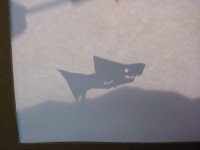 This rotation in the STEM Lab has 4th grade working on a project that combines digital and physical elements to make an interactive display. I adapted this activity from one done by a teacher I know in Virginia. (Link to her project guide is below.) I was overly ambitious in my additions for the first group, so some adjustments and refinements were necessary after the first class completed their projects.
This rotation in the STEM Lab has 4th grade working on a project that combines digital and physical elements to make an interactive display. I adapted this activity from one done by a teacher I know in Virginia. (Link to her project guide is below.) I was overly ambitious in my additions for the first group, so some adjustments and refinements were necessary after the first class completed their projects.

On the first day of the unit, students went on a virtual field trip to the Smithsonian Museum of Natural History. The "wandered" around the museum recording observations in their journals regarding the things they saw, how the objects were displayed, and anything else that they found interesting. We followed up with a discussion about what the purpose of a museum is. The students gave several great responses including: "so people can learn and discover things", "so people can see things they have never seen", and "so people can learn about life in the past". That day finished with students brainstorming a list of things they would include if they could design a room in a museum.
 The next day, I explained the project to the class. They were to plan a museum room that included 3 objects of their choosing. Each person would build a model of their imagined room using the STEM Lab staples of cardboard, glue, and construction paper. Students would work with a partner to use Scratch to program and digital version of each partner's room that used by key press events to switch between rooms. The rooms are narrated giving at least 2 facts about each object included. Finally, the model museum rooms would be linked via the Makey Makey to the team Scratch project so that when the door to each room is opened, it causes that part of the program to run.
The next day, I explained the project to the class. They were to plan a museum room that included 3 objects of their choosing. Each person would build a model of their imagined room using the STEM Lab staples of cardboard, glue, and construction paper. Students would work with a partner to use Scratch to program and digital version of each partner's room that used by key press events to switch between rooms. The rooms are narrated giving at least 2 facts about each object included. Finally, the model museum rooms would be linked via the Makey Makey to the team Scratch project so that when the door to each room is opened, it causes that part of the program to run.

 I gave the students a fair bit of leeway in what they added to their museums. This was so that they could include objects representing personal interests and passions. The only requirement was that they be able to give two facts about each object in their rooms. It has been interesting to see what objects the students have included. Some rooms are full of fancy cars or sharks, while others have favorite foods and athletes. The attention to detail that several students added to their physical models. As always, I have been really impressed by how the students helped each other to complete the elements of the project on time. For some, the coding comes more naturally and for others it is the building. I love how they all work together to ensure that everyone's project is finished on time.
I gave the students a fair bit of leeway in what they added to their museums. This was so that they could include objects representing personal interests and passions. The only requirement was that they be able to give two facts about each object in their rooms. It has been interesting to see what objects the students have included. Some rooms are full of fancy cars or sharks, while others have favorite foods and athletes. The attention to detail that several students added to their physical models. As always, I have been really impressed by how the students helped each other to complete the elements of the project on time. For some, the coding comes more naturally and for others it is the building. I love how they all work together to ensure that everyone's project is finished on time. I try to mix it up each year in the lab and to not repeat projects too often, but I am loving this one so far and can it it becoming a regular part of the lab curriculum.
I try to mix it up each year in the lab and to not repeat projects too often, but I am loving this one so far and can it it becoming a regular part of the lab curriculum.
The guide by Kathleen Fugle is here: Tiny Museum on Instructables.
The gallery of our projects is here (more added soon): Mini-Museum rooms.








